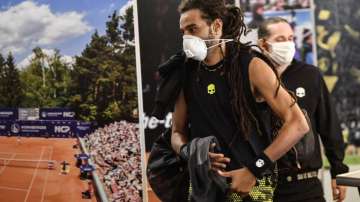There were no spectators, no line judges, no ballkids -- and no post-match handshake at the net -- as an exhibition tennis event got underway in Germany on Friday with professional players, a rare instance of live, televised sports held during the coronavirus pandemic.
Just three men were involved in each contest for what will be a four-day event at an academy near the small town of Höhr-Grenzhausen: two players, who sat on opposite sides of the indoor clay court, and a chair umpire.
“I like working with the crowd. I like having the energy on the court. There’s people watching, they get pumped, so that gives me a lot of energy and makes the thing more fun. ... It’s kind of hard that it’s gone completely,” Florian Broska, who plays college tennis at Mississippi State, told The Associated Press after his opening match Friday. “So I’m trying to get my own energy, but obviously it’s not the same.”
With the men’s and women’s pro tennis tours suspended at least until mid-July because of the COVID-19 outbreak, there is not much of a chance for players to play the sport or for fans to watch it. But this mini-tournament with a round-robin format and an eight-man field -- Dustin Brown, who upset Rafael Nadal at Wimbledon in 2015, is the biggest name -- is among a growing number of unsanctioned competitions dotting the tennis calendar.
Two more events are planned for the same venue in Germany later this month.
Friday’s matches were shown in the United States on Tennis Channel, which also will air a round-robin event from West Palm Beach, Florida, on May 8-10. That will involve four men vying for prize money: 2019 U.S. Open semifinalist Matteo Berrettini of Italy and top-60 Americans Reilly Opelka, Tennys Sandgren and Tommy Paul.
A similar event in the same place is scheduled for May 22-24 with four female pros in the top 60: Alison Riske, Amanda Anisimova, Danielle Collins and Ajla Tomljanovic.
Serena Williams’ coach, Patrick Mouratoglou, is setting up exhibitions at his tennis academy in Nice, France, with 10th-ranked David Goffin of Belgium slated to face 103rd-ranked Alexei Popyrin of Australia on May 16.
The Tennis Integrity Unit, which oversees anti-corruption efforts in the sport, issued a statement Friday to point out that while “a number of new tennis events” have not been “authorized or sanctioned by the governing bodies of tennis,” players, officials and support staff are still covered by the TIU’s rules.
“The TIU has, upon request, provided integrity-related information to some event organizers,” the statement read. “This does not constitute advice and can in no way be seen as an endorsement or approval for any event that does not come under its jurisdiction.”
These attempts to return to tennis in some form offer some insight into what sports might look like whenever they resume on a larger scale.
Germany has started to ease its lockdown measures in a cautious way. Major events are not going to be allowed any time soon; soccer at closed stadiums is being considered for later in May.
At the tennis exhibition, players wear masks when they aren’t on court, minimize contact with others and, as Broska noted, there is “hand sanitizer everywhere.”
While waiting to play, they watch matches through a window in the venue’s bar area while sitting in what Broska called “boxes,” individual areas separated by dividers.
Unmanned TV cameras stand in fixed positions.
“On the court, it doesn’t really change anything. At least, that’s what I should tell myself. When you’re on the court and you see the cameras at the beginning, you’re like: ‘Oh, shoot. Something is happening,’” said Broska, who lives near the venue.
U.S. college tennis doesn’t offer ranking points, making it hard for players to make their mark internationally. Broska said he isn’t being paid for the tournament, unlike his opponents, so he can retain his college eligibility.
“This is to show people that I can play tennis at that level,” Broska said, “even if I don’t have the ranking or the results that these guys have.”
